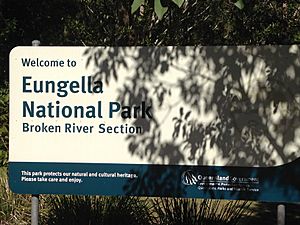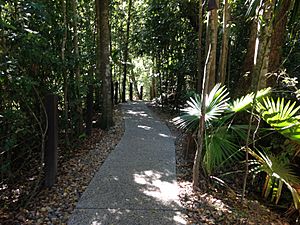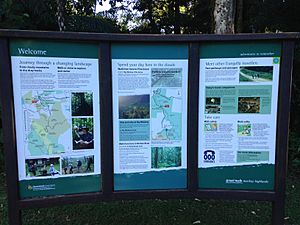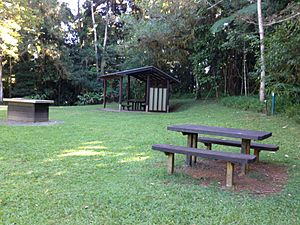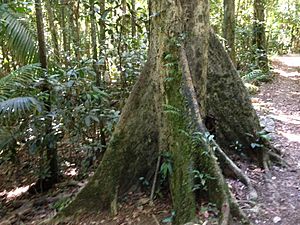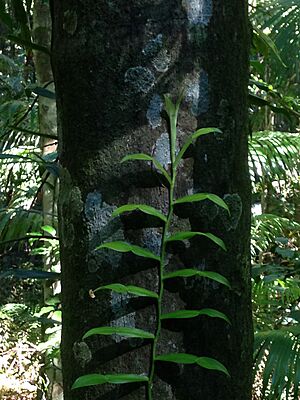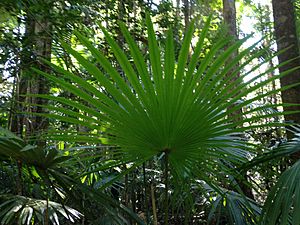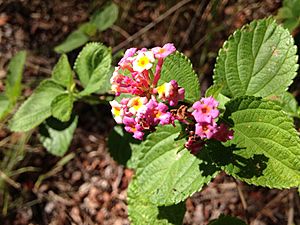Eungella National Park facts for kids
Quick facts for kids Eungella National ParkQueensland |
|
|---|---|
|
IUCN Category II (National Park)
|
|
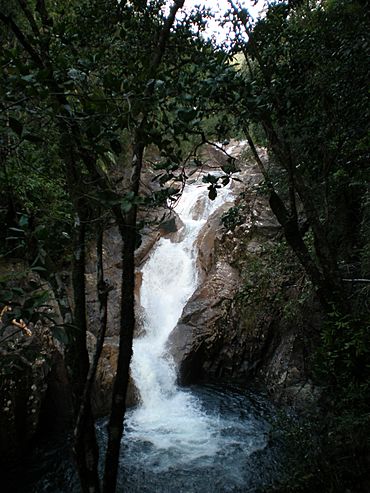
Araluen Falls in Eungella National Park
|
|
| Nearest town or city | Mackay |
| Established | 1941 |
| Area | 517 km2 (199.6 sq mi) |
| Managing authorities | Queensland Parks and Wildlife Service |
| Website | Eungella National Park |
| See also | Protected areas of Queensland |
Eungella (pronounced YUNG-gel-ə) is a small town in Australia. Its name means "Land of the clouds." It sits on the edge of the Clarke Range, about 80 km west of Mackay.
The town is famous for the national park that surrounds it. This park has the longest continuous stretch of subtropical rainforest in Australia. The original people of this land are the Wirri people. The park is full of thick rainforests and is well-known for its platypuses. A dam in the area also provides water for nearby towns like Collinsville and Mackay.
About Eungella National Park
Eungella National Park is found on a high, isolated mountain area. This area is about 80 km west of Mackay in central Queensland. The Eungella Plateau reaches heights of 1259 meters at Mount Dalrymple. It is part of the Clarke Range.
The park protects about half of the rainforest that was here before European settlement. Much of the original forest was cut down for timber. The rainforests here are very special because they are one of the most isolated patches of this type of forest in Australia.
History and Climate of Eungella
Eungella National Park was officially created in 1941. At that time, it covered about 49,610 hectares. In 1986, the park grew to include more land. Today, it covers 52,900 hectares.
The name Eungella comes from an Aboriginal word. It means 'land of the cloud'. The park gets a lot of rain, about 2240mm each year. This means it often looks like it's sitting in a cloud. The temperature in the park is usually about five degrees cooler than the areas around it.
Unique Animals and Plants
Eungella National Park is a special place for many Australian rainforest species. It is known for having many endemic species. Endemic means they are found only in this area and nowhere else in the world.
This area was a safe place for rainforests during dry periods in the past. Because of this, many unique species live here.
Endemic Species in Eungella
Some of the special animals found only here include:
- The Eungella spiny crayfish (Euastacus eungella)
- The Eungella leaf-tailed gecko (Phyllurus nepthys)
- The orange-spotted forest-skink (Tumbunascincus luteilateralis)
- The Eungella honeyeater (Bolemoreus hindwoodi)
- Three types of frogs:
- The Eungella tinker frog (Taudactylus liemi)
- The Eungella torrent frog (Taudactylus eungellensis)
- The northern gastric-brooding frog (Rheobatrachus vitellinus)
Plant Life in Eungella
The park is home to many different plants. There are 16 types of fungi, 19 mosses, 4 conifers, and 92 ferns. There are also 299 types of dicots and 54 types of monocots.
Much of the rainforest here is a complex vine forest. Many of these plant groups are sensitive to fire.
Special Dicot Plants
Elaeocarpus largiflorens is a rainforest tree that can grow up to 30 m tall. It is at the southern end of its natural range in Eungella. Its fruits are eaten and spread by many animals.
The Eungella hairy daisy (Ozothamnus eriocephalus) is a rare shrub. It is listed as vulnerable, meaning it is at risk of disappearing.
Omphalea celata is a small tree also listed as vulnerable. It was first described in 1994. This tree is a host plant for the zodiac moth (Alcides metaurus).
Ferns in the Park
The giant fern (Angiopteris evecta) is found in only a few places in southern Queensland, including Eungella. This fern needs a lot of water and humidity to grow its huge fronds. The vulnerable Dryopteris sparsa fern is also found here.
Animal Life in Eungella
More than 175 species of mammals, reptiles, birds, and amphibians have been seen in the park.
Birds of Eungella
There are 111 bird species recorded in Eungella National Park. The Eungella honeyeater (Lichenostomus hindwoodi) lives only in the high rainforests of the Clarke Range. It was discovered in 1975, making it the most recently described Australian bird species.
Other interesting birds include:
- The red-necked crake (Rallina tricolor), which was first seen here in 1981.
- The buff-breasted paradise kingfisher (Tanysiptera sylvia).
- The white-browed robin (Poecilodryas superciliosa).
- The regent bowerbird (Sericulus chrysocephalus).
- The brown thornbill (Acanthiza pusilla).
- The glossy black cockatoo (Calyptorhynchus lathami).
Australian swiftlets (Aerodramus terraereginae) nest in caves in the Finch Hatton Creek area.
Amphibians and Their Decline
Sixteen amphibian species have been recorded in the park. Many amphibians around the world are declining rapidly. This is due to habitat loss, pollution, and diseases. A fungus called Batrachochytrium dendrobatidis is a major threat to frogs.
Eungella National Park is one of eleven areas with many unique frog species. Of the three frog species found only here, two are still alive today:
- The Eungella dayfrog (Taudactylus eungellensis)
- The Eungella tinker frog (Taudactylus liemi)
Sadly, one species, the northern gastric brooding frog (Rheobatrachus vitellinus), is believed to be extinct.
Eungella Dayfrog
The Eungella dayfrog was once common but its numbers have dropped. It is now considered endangered. This frog is one of only two species known to use body language to communicate. They do small hops and arm movements. This behavior might have developed because the noisy mountain streams make it hard to hear calls.
Eungella Tinkerfrog
The Eungella tinkerfrog is considered near threatened. It lives in rainforests at different heights. Threats to this frog include grazing animals, cane toads, and the chytrid fungus.
Northern Gastric Brooding Frog
The northern gastric brooding frog was discovered in 1984. However, it has not been seen since March 1985 and is thought to be extinct. This frog was unique because the mother would swallow her fertilized eggs. She would then 'give birth' to the young through her mouth. It lived only in undisturbed rainforests within Eungella National Park.
Mammals in the Park
Twenty-eight mammal species have been recorded in the park. This includes several types of bats.
Platypus (Ornithorhynchus anatinus) are often seen at the viewing platform at Broken River. This is the most visited spot in the park. Platypuses are unique because they use electric signals to find their prey. They are well-suited for life in water. They have very thick fur, webbed feet, and a flat tail. They are excellent swimmers.
Reptiles of Eungella
Twenty species of reptiles live in the park. Three types of leaf-tailed geckos are found here. P. nepthys is found only in the Clarke Range. The orange-sided rainforest skink (Tumbunascincus luteilateralis) is also unique to this area. It lives in moist rainforests above 900m, often near rotting logs.
Insects of Eungella
Eungella National Park has several insect species found only here or in a limited range. Studies have shown that the high, isolated rainforests of Eungella have unique groups of flies.
Other unique insects include:
- The katydid Phricta zwicka.
- The Megalopteran Protochauliodes eungella.
- Two new species of dragonflies: Austroaeschna christine and A. eungella.
A survey in 1993 found 37 butterfly species in the park.
Crustaceans
The Eungella spiny crayfish is found only in the creeks of the Clarke Range. It is listed as critically endangered. This is because it lives in a small area and its habitat is threatened. Threats include feral pigs, foxes, cats, and cane toads. It is also vulnerable to climate change.
Threats to the Park
The plants and animals of Eungella National Park face several threats. These include habitat loss, introduced species, fire, and human impacts.
Pest Plants and Animals
Many introduced animals have been found in the park. These include the cane toad, red fox, feral cat, rabbit, black rat, house mouse, and feral pig.
- Pigs dig up the ground, which helps weeds spread. They also harm native plants and animals. They can carry diseases like cinnamon fungus. This fungus has killed about 20% of the rainforest in one area of the Clarke Range.
- Cats, foxes, and feral dogs hunt native animals. They also compete for food and can spread diseases. Cats are known to hunt many native birds, mammals, and reptiles in Australia.
- Weeds like lantana (Lantana camara) and blue morning glory (Ipomoea indica) are common. They grow on the edges of the park and along roads. Lantana is a serious weed in Queensland. Other flammable weeds are also found here, increasing fire risk.
Fire Danger
Fire is a major threat to the rainforests of Eungella National Park. Fires can break the rainforest into smaller pieces. This makes it harder for plants and animals to survive. Fire can also change the types of species in the forest forever. It can reduce leaf litter and fallen logs, which are important habitats for many species.
Park Management
Eungella National Park is managed by the Queensland Department of National Parks, Sport and Racing. National Parks are managed to protect their natural state and cultural values. They also aim to allow nature-based and sustainable use of the park.
Economic Benefits
National parks help protect nature, but they also bring economic benefits. They create jobs and encourage visitors to spend money in local areas. A survey in 2001 estimated that visitors to Eungella National Park spend $10.9 million in the local region each year.
Visitor Facilities
- Camping is allowed at Fern Flat campground, but you can only get there by walking.
- The Broken River picnic area has facilities for day visitors.
- There are over 20 km of bushwalking tracks. Some tracks have amazing scenic lookouts.
- A special platform on the Broken River is a great place to see platypus, eels, and turtles.

See also
 In Spanish: Parque nacional Eungella para niños
In Spanish: Parque nacional Eungella para niños



